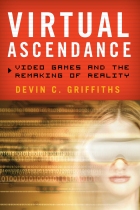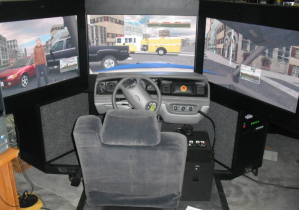 In my last post, I said that avatars were all the rage, and they are—and most likely will only become more so within the next five years. Why then? That’s when Philip Rosedale believes we’ll see intricately detailed virtual worlds that begin to rival reality. If you don’t know Rosedale, you know his work: back in 2000, he created the first massively multiuser 3D virtual experience. It was more alternate reality than game, and with perhaps a nod to his desire to build a world that would become an essential component of daily existence, Rosedale called his creation Second Life.
In my last post, I said that avatars were all the rage, and they are—and most likely will only become more so within the next five years. Why then? That’s when Philip Rosedale believes we’ll see intricately detailed virtual worlds that begin to rival reality. If you don’t know Rosedale, you know his work: back in 2000, he created the first massively multiuser 3D virtual experience. It was more alternate reality than game, and with perhaps a nod to his desire to build a world that would become an essential component of daily existence, Rosedale called his creation Second Life.
For many people, Second Life became just that. Users (residents, in the SL lexicon) could log in, explore the world, build virtual places of their own, shop, find support groups, run businesses, have relationships… in short, everything people do in “real” life. The experience is engaging—so much so that some actually find it as involving as their first lives, if not more so. However, no one would mistake Second Life for reality: visually it resembles animated film—the fidelity is good, but it has nothing on the real world. To become truly immersive, the virtual component must be thoroughly unquestionable—enough to fool our brains into believing that we’re in the grip of the real.
 That’s where we’re headed—rushing headlong towards, in fact—and Rosedale is at the fore in getting us there. At the recent Augmented World Expo in Santa Clara, CA, he dropped a few hints as to what his new company, High Fidelity, is cooking up. At its heart, it could be a 3D world that’s virtually indistinguishable from reality, offering a vastly increased speed of interaction, employing body tracking sensors for more life-like avatars, and applying the computing power of tens of millions of devices in the hands of end-users the world over. Within five years, he believes that any mobile device will be able to access and interact with photo-realistic virtual worlds in real time, with no discernable lag.
That’s where we’re headed—rushing headlong towards, in fact—and Rosedale is at the fore in getting us there. At the recent Augmented World Expo in Santa Clara, CA, he dropped a few hints as to what his new company, High Fidelity, is cooking up. At its heart, it could be a 3D world that’s virtually indistinguishable from reality, offering a vastly increased speed of interaction, employing body tracking sensors for more life-like avatars, and applying the computing power of tens of millions of devices in the hands of end-users the world over. Within five years, he believes that any mobile device will be able to access and interact with photo-realistic virtual worlds in real time, with no discernable lag.
We’re already seeing the first signs of this. Last summer, I spoke with Kim Libreri at ILM (this was before the Disney purchase) regarding the stunning but now-doomed Star Wars 1313:
We’ve got to a point where many of the techniques that we would have taken as our bread-and-butter at ILM a decade ago are now absolutely achievable in real-time. In fact, you know, a render at ILM—or any visual effects company—can take ten hours per single frame. This is running at thirty-three milliseconds—that’s like a million times faster than what we would have on a normal movie. But the graphics technology is so advanced now that the raw horsepower is there to do some incredible things.”
 And this is today. Within five years, he told me, they’ll achieve absolute, indistinguishable-from-reality photo-realism. Regarding the ability of mobile devices to connect to the type of virtual world Rosedale envisions, he’s a little more conservative. In this case, the bottleneck isn’t computing power but the speed of Internet connectivity, which depends on more factors. Still, Libreri sees that being cleared within 10 years. And that’s it—we’ll have removed the last barrier to delivering hyper-realistic, fully immersive virtual worlds to any device, anywhere. From that point on, the possibilities will be limitless, bounded only by the extent of our imagination.
And this is today. Within five years, he told me, they’ll achieve absolute, indistinguishable-from-reality photo-realism. Regarding the ability of mobile devices to connect to the type of virtual world Rosedale envisions, he’s a little more conservative. In this case, the bottleneck isn’t computing power but the speed of Internet connectivity, which depends on more factors. Still, Libreri sees that being cleared within 10 years. And that’s it—we’ll have removed the last barrier to delivering hyper-realistic, fully immersive virtual worlds to any device, anywhere. From that point on, the possibilities will be limitless, bounded only by the extent of our imagination.
The implications of this, though, are another matter entirely—and one I’ll take up in my next post. Until then, I’ll leave you with a taste of the possible: Star Wars 1313 videos here…
… and here.
You can read more about Philip Rosedale’s Augmented World Expo talk here.
And you can learn more about the Augmented World Expo here.

 RealD 3D is so last year. Now, if you’re old enough to remember the Dark Ages of 3D cinema, when you had to wear those funny red and green “glasses” and exert an effort of will to lose yourself in a movie, then you may scoff at this. Until yesterday, I myself would have called you crazy for suggesting such a thing. After all, just two years ago, I sat in a darkened theater dumbstruck as the landscapes of Pandora leaped off the screen. Whatever your opinion of the film, there’s no denying Cameron’s technical achievement in bringing Avatar vividly and viscerally to life. Visually, it was captivating.
RealD 3D is so last year. Now, if you’re old enough to remember the Dark Ages of 3D cinema, when you had to wear those funny red and green “glasses” and exert an effort of will to lose yourself in a movie, then you may scoff at this. Until yesterday, I myself would have called you crazy for suggesting such a thing. After all, just two years ago, I sat in a darkened theater dumbstruck as the landscapes of Pandora leaped off the screen. Whatever your opinion of the film, there’s no denying Cameron’s technical achievement in bringing Avatar vividly and viscerally to life. Visually, it was captivating. Though projection mapping is relatively new, the real innovation behind the Sony videos is how they were done. Traditional projection mapping’s downfall is a matter of perspective: the effect is visible only from a single, fixed point. Creating a 3D, immersive movie with the audience at the center that also changes angles and viewpoints was, therefore, impossible. Sony’s production team cleared this hurdle by combining existing technology from two distinct realms of entertainment: movies and videogames. The team connected a standard Steadicam camera mount to several Playstation Move motion controllers, and synced them up with EyeToy motion-capture cameras (used for Sony’s PS3 console). The results are… well, see for yourself. And as you’re watching, bear in mind that these are, according to everyone on the production team, entirely real-time and completely free from post-production editing or enhancement (scroll down to the end to see the
Though projection mapping is relatively new, the real innovation behind the Sony videos is how they were done. Traditional projection mapping’s downfall is a matter of perspective: the effect is visible only from a single, fixed point. Creating a 3D, immersive movie with the audience at the center that also changes angles and viewpoints was, therefore, impossible. Sony’s production team cleared this hurdle by combining existing technology from two distinct realms of entertainment: movies and videogames. The team connected a standard Steadicam camera mount to several Playstation Move motion controllers, and synced them up with EyeToy motion-capture cameras (used for Sony’s PS3 console). The results are… well, see for yourself. And as you’re watching, bear in mind that these are, according to everyone on the production team, entirely real-time and completely free from post-production editing or enhancement (scroll down to the end to see the  Public safety is a tricky business. It is, by its nature, risky: Paramedics, firefighters, police, EMTs, first responders—they have dangerous jobs, and often put themselves in harm’s way to help others. When they go to work, lives are often at stake—sometimes theirs, sometimes ours, and sometimes both. For reasons that should be obvious, adequate and effective training of individuals pursuing this line of work is absolutely critical: Call me crazy, but getting thrown cold into an emergency situation doesn’t strike me as the best way to assess your skills.
Public safety is a tricky business. It is, by its nature, risky: Paramedics, firefighters, police, EMTs, first responders—they have dangerous jobs, and often put themselves in harm’s way to help others. When they go to work, lives are often at stake—sometimes theirs, sometimes ours, and sometimes both. For reasons that should be obvious, adequate and effective training of individuals pursuing this line of work is absolutely critical: Call me crazy, but getting thrown cold into an emergency situation doesn’t strike me as the best way to assess your skills. Remember the scene in The Empire Strikes Back when Yoda lifts Luke’s X-wing out of the swamp with the Force? Or when Darth Vader, using only his mind, repeatedly smashes Luke with a variety of blunt objects? That was cool, right? I mean, who wouldn’t want to be able to move things just by thinking about it.
Remember the scene in The Empire Strikes Back when Yoda lifts Luke’s X-wing out of the swamp with the Force? Or when Darth Vader, using only his mind, repeatedly smashes Luke with a variety of blunt objects? That was cool, right? I mean, who wouldn’t want to be able to move things just by thinking about it. A new technology developed at Disney Research, Pittsburgh (DRP) is poised to usher in a brave new world of gaming. Called Surround Haptics, it allows game players (and film viewers, for that matter) to feel a wide range of sensations—from gentle caresses to bone-jarring collisions. Initially demonstrated during the Emerging Technology Exhibition at SIGGRAPH 2011, it was used to enhance a driving simulator, allowing drivers to feel road imperfections, skidding, braking, acceleration, collisions, jumping and landing, even objects striking the car. It’s all thanks to a gaming chair equipped with inexpensive vibrating actuators that transform digital information into physical sensation. Said Ivan Poupyrev, senior research scientist at DRP,
A new technology developed at Disney Research, Pittsburgh (DRP) is poised to usher in a brave new world of gaming. Called Surround Haptics, it allows game players (and film viewers, for that matter) to feel a wide range of sensations—from gentle caresses to bone-jarring collisions. Initially demonstrated during the Emerging Technology Exhibition at SIGGRAPH 2011, it was used to enhance a driving simulator, allowing drivers to feel road imperfections, skidding, braking, acceleration, collisions, jumping and landing, even objects striking the car. It’s all thanks to a gaming chair equipped with inexpensive vibrating actuators that transform digital information into physical sensation. Said Ivan Poupyrev, senior research scientist at DRP,